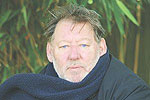Martin Rushent: 1948 – 2011
Published on June 28th, 2011 in: Eulogy, Music |By Emily Carney

I am shocked to learn that Martin Rushent, perhaps one of the most iconic Punk/New Wave producers of the late 1970s and early 1980s, died on June 4 of this year. I was supposed to interview Martin via Skype a couple of years back; as it was, our extremely busy schedules prevented this from happening. Although I didn’t know him well, Martin gave the impression of being a personable, eminently cool man who just happened to have produced some of the best, most seminal records of the New Wave era. Martin was more than willing to discuss his interests with his fans and followers, which I find admirable.
While many music listeners remember Martin as having produced perhaps the most ubiquitous early 1980s album of all time (The Human League’s Dare, which no one could get away from in 1981), personally I enjoy his productions of late 1970s punk bands like The Stranglers and The Buzzcocks. My favorite offerings from Martin involve his collaborations with former Buzzcocks front man Pete Shelley. Shelley’s Homosapien and XL1 albums extended the DIY punk attitude of the Buzzcocks through the newer medium of electro-pop; the sounds on these records influenced later acts like The Pet Shop Boys. The lead-off single on Homosapien combined acoustic-electro aspects to great effect.
Martin also pioneered the process of extended dance remixes via the Human League’s Love and Dancing, released in 1982 after the band’s Dare had reached stratospheric levels of success. Making this album pushed Martin’s production talents to their apex, as realizing some of the sounds on Love and Dancing required much splicing of audio tape and literally thousands of edits. This album would, like Dare, also go platinum, and is a great primer for those interested in record production techniques.
For a time, Martin retreated from the world of music, and became a full-time father. His productions would again inspire interest in the early part of the last decade; producers in the new millennium such as Richard X and Stuart Price (Les Rhythmes Digitales/Jacques Lu Cont) would cite his work as being influential and powerful (Richard X did several mash-ups involving songs from Dare). At the time of his death, Martin was working on a 30th anniversary version of Dare.
Martin Rushent was more than just an architect of sound; along with post-punk producers like Martin Hannett—Joy Division’s producer who died in 1991—he shaped the sonic landscape of an entire generation. His unique artistic presence will always be missed.
Time limit is exhausted. Please reload the CAPTCHA.